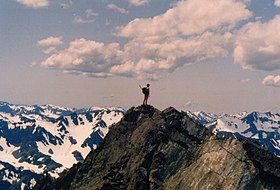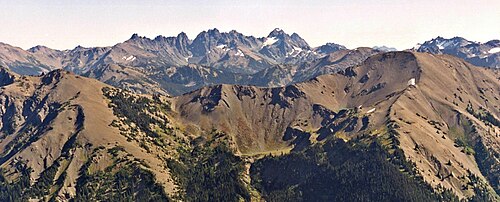
Mount Anderson is a 7,330-foot-high (2,234 m) peak in the Olympic Mountains of the Pacific Northwest. Rising in the center of Olympic National Park in Washington state, it is the second highest peak on the Anderson Massif, after West Peak. Anderson Glacier used to be located in a cirque on the mountain's southern flank while Eel Glacier is in another cirque, northwest of the summit. Hanging Glacier is on the east side of a ridge which extends north from the peak.

Mount Deception is a peak in the Olympic Mountains of Cascadia. It is in Olympic National Park on the Olympic Peninsula in the U.S. state of Washington.
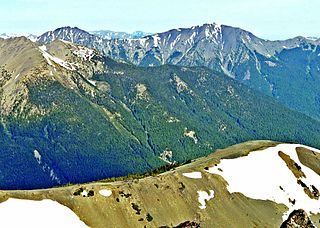
Gray Wolf Ridge is a spur of the northeastern Olympic Mountains in Washington's Olympic Peninsula. Arcing northeast from the Mount Deception - Needles - Mount Clark - Mount Walkinshaw massif, Gray Wolf Ridge is covered by alpine and subalpine forests up to the timberline, leaving the upper elevations of the ridge's six rocky peaks vegetated only by fragile alpine meadows. The ridge and its component mountains are markedly steep, as is its primary access route, the Maynard Burn Trail (#816) of Olympic National Forest. The higher, western segment of Gray Wolf Ridge lies within the boundary of Olympic National Park.
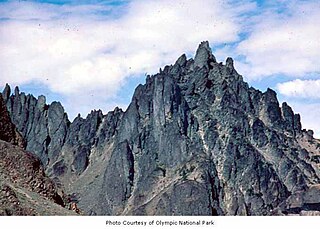
Mount Clark is a 7,528-foot (2,295-metre) mountain summit located within Olympic National Park in Jefferson County of Washington state. Its nearest higher peak is Sweat Spire (7,580 ft) on Mount Johnson, 0.26 mi (0.42 km) to the southwest, and Mount Walkinshaw is set 0.9 mi (1.4 km) to the north. It is the second highest peak in The Needles range, which is a subrange of the Olympic Mountains, and seventh highest in the Olympic Mountains. The climbing routes on Mt. Clark start at Class 3 scrambling and range up to Class 5.5 via the central South Face. Precipitation runoff from the mountain drains into tributaries of the Dungeness River.
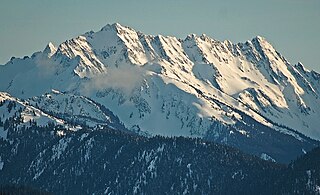
West Peak is a 7,365-foot-high (2,245 m) peak in the Olympic Mountains, in Jefferson County of Washington state. Rising in the center of Olympic National Park, it is the highest peak on the Anderson Massif. West Peak is the hydrographic apex of the Olympic Mountains, with precipitation runoff flowing outward to the Pacific Ocean via Quinault River, the Strait of Juan de Fuca via Elwha River, and Hood Canal via the Dosewallips River. The Eel Glacier is situated in a cirque east of the summit, and an unnamed glacier resides in the south cirque. Its nearest higher peak is Mount Mystery, 7.73 miles (12.44 km) to the northeast. The first ascent of the peak was made in 1930 by E. B. Hamilton. Legend has it that the mountain's name is for Mr. West, a participant in the 1890 O'Neil Expedition, rather than for its apparent position on the Anderson Massif. The West Branch of the Quinault River was named after him in 1890.

Mount Fricaba is a 7,139-foot-elevation (2,176 m) double summit mountain located in the Olympic Mountains, in Jefferson County of Washington state. It is situated on the shared border of Olympic National Park with Buckhorn Wilderness, and is the highest point in that wilderness, as well as the Olympic National Forest. Its nearest higher peak is Hal Foss Peak, 0.74 miles (1.19 km) to the southwest. Precipitation runoff from the peak drains east into headwaters of the Dungeness River, or west into Deception Creek which is a tributary of the Dosewallips River. The mountain's name was officially adopted in 1961 by the United States Board on Geographic Names based on usage by The Mountaineers since 1907, and inclusion in Fred Beckey's "Climber's Guide to the Cascade and Olympic Mountains of Washington" published in 1949. The first ascent of the mountain was made in 1957 by Don Bechlem and Jack Newman.

Mount Henderson is a 6,003 ft mountain summit located in the Olympic Mountains, in Mason County of Washington state. It is situated on the shared boundary of Olympic National Park with Mount Skokomish Wilderness. Its nearest higher peak is Mount Skokomish, 0.91 mi (1.46 km) to the east-northeast. Precipitation runoff from the mountain drains into the Hamma Hamma River and Skokomish River. The mountain's name honors Louis Forniquet Henderson (1853-1942), a pioneering botanist and mountaineer who accompanied Lieutenant O'Neil on his 1890 expedition into the Olympic Mountains.

Sundial is a 7,200+ ft mountain summit located within Olympic National Park, in Jefferson County of Washington state. Sundial is part of The Needles range, which is a subrange of the Olympic Mountains. Its nearest higher neighbor is Mount Clark, 0.27 mi (0.43 km) to the northwest, and Mount Johnson is set 0.45 mi (0.72 km) to the west. The climbing routes on Sundial start at class 3 scrambling via the East Face, and range up to class 5 via the South Side Face. The first ascent of the mountain was made in 1944 by Adel and William Degenhardt. The mountain is so named because the time of day can be approximated as an observer in Royal Basin watches the sun's rays make their way down the east face of this mountain in the morning. Precipitation runoff from the mountain drains into Royal Creek which is a tributary of the Dungeness River.

Mount Noyes is a 6,173-foot (1,882 m) mountain summit located deep within Olympic National Park in Jefferson County of Washington state. Part of the Olympic Mountains, Mount Noyes is situated seven miles southeast of Mount Olympus, and set within the Daniel J. Evans Wilderness. The nearest higher neighbor is Mount Meany, 0.6 miles (0.97 km) to the north, and Mount Seattle rises one mile to the southeast. Noyes is a major triple divide point with precipitation runoff from the mountain draining east into the headwaters of the Elwha River, west into headwaters of Saghalie Creek which is a tributary of the Queets River, and south into headwaters of Seattle Creek which is a tributary of the Quinault River. Topographic relief is significant as the east, west, and south aspects of the peak each rise 2,200 feet (670 m) in approximately one mile.

Mount Wilder is a 5,939-foot (1,810-metre) mountain summit located near the head of the Elwha Valley, deep within Olympic National Park in Jefferson County of Washington state. Part of the Olympic Mountains, Wilder represents the southernmost peak of the Bailey Range. It is situated 8.7 miles east-southeast of Mount Olympus, and is set within the Daniel J. Evans Wilderness. Neighbors include line parent Mount Dana, 2.3 miles (3.7 km) to the northeast, and Mount Seattle rises 3.7 miles to the southwest. The headwaters of the Goldie River form on the south slope of the mountain, and precipitation runoff from the mountain drains into Goldie River and other tributaries of the Elwha River. Topographic relief is significant as the south aspect of the peak rises nearly 3,800 feet (1,160 m) in less than two miles.

Mount Delabarre is a remote 6,024-foot (1,836-metre) mountain summit deep within Olympic National Park in Jefferson County of Washington state. Part of the Olympic Mountains, Mount Delabarre is 12.4 miles southeast of Mount Olympus, set within the Daniel J. Evans Wilderness. The nearest higher neighbor is line parent Mount Christie, 2.5 miles to the west-northwest. Precipitation runoff from the mountain drains north into headwaters of Delabarre Creek, which is a tributary of the Elwha River, and south into Rustler Creek, which is a tributary of the North Fork Quinault River. Topographic relief is significant as the southwest aspect of the peak rises 3,400 feet (1,036 m) above Rustler Creek in approximately one mile.

Cat Peak is a 5,940-foot (1,810-metre) mountain summit within Olympic National Park in Clallam County of Washington state.
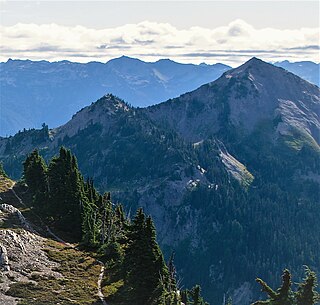
Mount Scott is a 5,913-foot (1,802-metre) mountain summit located within Olympic National Park in Jefferson County of Washington state.
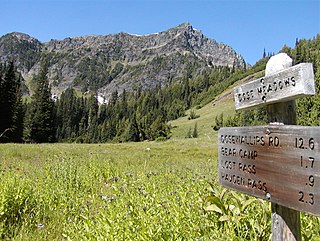
Mount Fromme is a 6,705-foot (2,044-metre) mountain summit in Olympic National Park in Jefferson County of Washington state. It is situated at the head of Dosewallips River, within the Daniel J. Evans Wilderness. The nearest higher neighbor is Mount Claywood, 0.6 mi (0.97 km) to the northwest. Other nearby peaks include Lost Peak, 1.8 mi (2.9 km) to the northeast, and Sentinel Peak, 1.4 mi (2.3 km) to the southeast. Precipitation runoff from the mountain drains east into headwaters of the Dosewallips River, and west into Hayes River, which is a tributary of the Elwha River. Topographic relief is significant as the summit rises 2,250 feet (685 m) above Dose Meadows in approximately one mile.

Mount Barnes is a 5,987-foot (1,825-metre) mountain summit in Olympic National Park in Jefferson County of Washington state. Mount Barnes is part of the Bailey Range, which is a subrange of the Olympic Mountains, and is set within the Daniel J. Evans Wilderness. Neighbors include Mount Queets, 1.7 mi (2.7 km) to the southwest, and Mount Olympus is set 6.2 mi (10.0 km) to the west. Precipitation runoff from the mountain drains west into the Queets River, south into headwaters of the Elwha River, and northeast into Goldie River which is a tributary of the Elwha. Topographic relief is significant as the summit rises 3,200 feet (975 m) above Elwha Basin in approximately two miles.

Mount Childs is a 6,193-foot (1,888-metre) mountain summit in Olympic National Park in Jefferson County of Washington state. Mount Childs is part of the Bailey Range, which is a subrange of the Olympic Mountains, and is set within the Daniel J. Evans Wilderness. Neighbors include line parent Mount Pulitzer, 1.7 mi (2.7 km) to the north, Mount Barnes, 2 mi (3.2 km) to the south, and Mount Olympus is situated 5.6 mi (9.0 km) to the west. Precipitation runoff from the mountain drains west into headwaters of the Hoh River, and east into Goldie River, which is a tributary of the Elwha River. The first ascent of the summit was made August 6, 1961, by Doug Waali, Bob Wood, and Kent Heathershaw via the east slope.
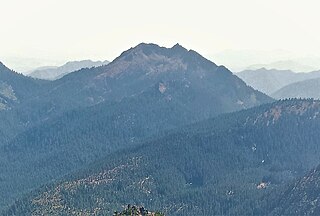
Copper Mountain is a 5,425-foot (1,654 m) mountain summit located in the southeast portion of the Olympic Mountains, in Mason County of Washington state. It is situated on the boundary shared by Daniel J. Evans Wilderness and Mount Skokomish Wilderness, as well as the shared common border of Olympic National Park with Olympic National Forest. The nearest higher neighbor is Mount Ellinor, 1.67 miles (2.69 km) to the east. Wagonwheel Lake lies immediately north of the peak. Topographic relief is significant as the summit rises nearly 4,700 feet (1,400 m) above the Staircase Ranger Station at Lake Cushman in approximately 1.5 miles (2.4 km). Precipitation runoff from the mountain drains north into the Hamma Hamma River, and south into the North Fork Skokomish River, thence Lake Cushman.
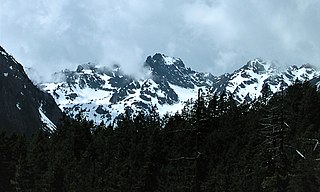
Adelaide Peak is a 7,300-foot-elevation mountain summit located in the Olympic Mountains, in Jefferson County of Washington state. It is situated within Olympic National Park, and is set within the Daniel J. Evans Wilderness. It is part of The Needles range, which is a subset of the Olympic range. The nearest higher peak is Mount Clark, 0.3 mi (0.48 km) to the south, and Mount Walkinshaw rises 0.66 mi (1.06 km) to the north-northwest. The peak is in the rain shadow of the Olympic Range, resulting in less precipitation than Mount Olympus and the western Olympics receive. Precipitation runoff from the mountain drains east into Royal Creek, and west into Gray Wolf River, which are both within the drainage basin of the Dungeness River. Topographic relief is significant as the east aspect rises 2,600 feet (793 m) above Royal Creek in less than one mile.

Mount Lawson is a 5,401-foot (1,646 m) mountain summit in Jefferson County of Washington state.
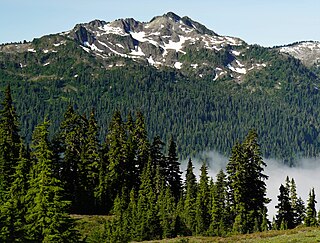
Mount Zindorf is a 5,539-foot (1,688 m) mountain summit in Jefferson County of Washington state.



